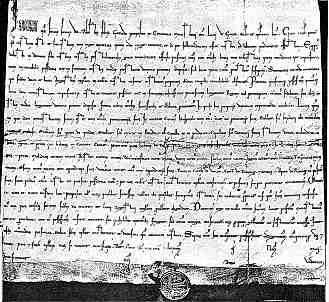 |
| Papal
Bulls (3) |
| A
notably simplified form of the papal
bull, which provided grants or favours but was not so elaborate as
the privilege, was referred to as a titulus.
It was essentially a charter,
but lacked some of the complex features of the solemn diploma. |
 |
Bull
of Innocent III, of 1208 to the monastery of St Luzi in Chur (Chur, Bischöfliches
Archiv). |
 |
|
The
above example is written in a small neat diplomatic
minuscule without too many elaborations, but it does use the papal
knot abbreviation mark and stretches the st letter combination. However, there is no elongated heading apart from
the name of the pope. The final clause is relatively simple, with a plain
threat that an omnipotent God and Saints Peter and Paul will deal with
any transgressors. There is no Amen, no
sign manual or Bene Valete, no long lists
of witnesses and the date is in a relatively simple format. The bulla
is attached by a silk thread and bears the heads of Saints Peter and Paul. |
| At
another stage down the levels of formality were documents sometimes known
as mandamenta, which were letters containing
orders, advice or instructions. These might be considered the papal equivalent
of a writ. |
 |
Papal
bull of Pope Innocent III of 1213, commanding the peoples of Ireland to abide
sincerely in fealty to John, King of the English, and his heirs (Public Record
Office, Museum, Case A, No.16). |
| The
above example has a much simplified diplomatic minuscule script,
no elaborate headings, graphic devices or witness lists and a simplified
form of date. The seal, which is not visible in the photograph, is attached
with hemp, as is usual in this grade of document. The interesting circular
graphical device at the bottom is the rubber stamp of the Public Record
Office, plonked right into the middle of the dating clause. Sigh.... |
| Papal
bulls, like any other kind of charter, were sent from the originating
agency to the recipients, where they were kept or lost or stolen at the
Reformation or burnt in fires, or generally subjected to the various hazards
that befall dispersed documents. They are to be found scattered across
the length and breadth of western Christendom. I have even seen them for sale on eBay. Copies were kept in registers
in the papal chancery,
more extensively as the middle ages progressed. By the later middle ages
the sheer volume of material is so vast that heroic attempts to publish
it systematically have been constrained by the enormity of the task. |
 |
Funerary
effigy of a 14th century pope, from the Petit Palais Museum in Avignon. |
 previous
page previous
page |
 Categories
of Documents Categories
of Documents |
|
 |
 |
 |
 |



